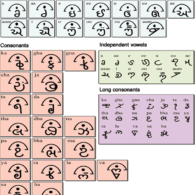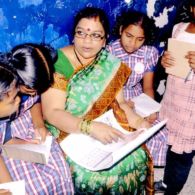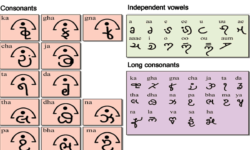Profile
Bagatha is one of nearly twenty scripts created by Dr. Prasanna Sree for indigenous and minority groups, mostly in Andhra Pradesh. In each case, the design of the script reflects some iconic feature of the culture of that linguistic community. She writes:Bagatha is spoken in the Paderu, Sujanakota, Karakapalli, Tajangi, Devarapalli and Peddavalasa hills by the Bagatha (also called Bhakta, Bhagada, Bogatha and Bhagatha), a Scheduled Tribe who in 1981 numbered 87,994. The Bagathas speak Bagatha and Telugu with a characteristic hill accent. Those who live [in the] border areas of Odisha State also speak a form of Odia.
Being expert archers, the Bagatha served the seventeenth-century Golconda and Gangaraju Madugole chieftains of the Visakhapatnam Agency as their army personnel. They showed so much devotion that they were recognized as their devotees, or bhaktas. The name Bhaktas later became Bagathas. In appreciation of their military services the chieftains appointed them as local chiefs. Due to this shift in status, the Bagatha claimed themselves as a warrior tribe, expanded geographically, developed politically and acquired social supremacy in the tribal area over a time span of about fifty years from the late seventeenth century to the early eighteenth century.
Nuclear families are predominant over joint families among Bagatas. They are patriarchal, patrilineal, and patrilocal. In the absence of a son, the daughter inherits the property of the father.
Agriculture is the mainstay of their livelihood while agricultural labor and the collection of Non Timber Forest Products are subsidiary occupations.
There are traditional councils at village level with some representatives called peddamanusulu. Most internal disputes are settled by these traditional councils, who have the authority to impose penalties on the guilty.
The Bagatha tribe invariably constructs huts following a domed or semi-circular design. The dot represents the sun, to indicate their ancestral distinctness. All the letters in their alphabet, then, are designed with the same dome shape as their houses.
You can help support our research, education and advocacy work. Please consider making a donation today.






